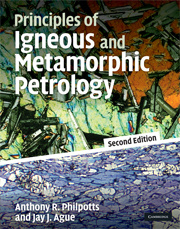Book contents
- Frontmatter
- Contents
- Preface
- Acknowledgments
- List of units
- 1 Introduction
- 2 Physical properties of magma
- 3 Intrusion of magma
- 4 Forms of igneous bodies
- 5 Cooling of igneous bodies and other diffusion processes
- 6 Classification of igneous rocks
- 7 Introduction to thermodynamics
- 8 Free energy and phase equilibria
- 9 Thermodynamics of solutions
- 10 Phase equilibria in igneous systems
- 11 Effects of volatiles on melt equilibria
- 12 Crystal growth
- 13 Isotope geochemistry related to petrology
- 14 Magmatic processes
- 15 Igneous rock associations
- 16 Metamorphism and metamorphic facies
- 17 Deformation and textures of metamorphic rocks
- 18 Graphical analysis of metamorphic mineral assemblages
- 19 Geothermometry, geobarometry, and mineral reactions among solid solutions
- 20 Mineral reactions involving H2O and CO2
- 21 Material transport during metamorphism
- 22 Pressure–temperature–time paths and heat transfer during metamorphism
- 23 Origin of rocks
- Answers to selected numerical problems
- References
- Index
13 - Isotope geochemistry related to petrology
- Frontmatter
- Contents
- Preface
- Acknowledgments
- List of units
- 1 Introduction
- 2 Physical properties of magma
- 3 Intrusion of magma
- 4 Forms of igneous bodies
- 5 Cooling of igneous bodies and other diffusion processes
- 6 Classification of igneous rocks
- 7 Introduction to thermodynamics
- 8 Free energy and phase equilibria
- 9 Thermodynamics of solutions
- 10 Phase equilibria in igneous systems
- 11 Effects of volatiles on melt equilibria
- 12 Crystal growth
- 13 Isotope geochemistry related to petrology
- 14 Magmatic processes
- 15 Igneous rock associations
- 16 Metamorphism and metamorphic facies
- 17 Deformation and textures of metamorphic rocks
- 18 Graphical analysis of metamorphic mineral assemblages
- 19 Geothermometry, geobarometry, and mineral reactions among solid solutions
- 20 Mineral reactions involving H2O and CO2
- 21 Material transport during metamorphism
- 22 Pressure–temperature–time paths and heat transfer during metamorphism
- 23 Origin of rocks
- Answers to selected numerical problems
- References
- Index
Summary
INTRODUCTION
Some of the major petrologic advances in recent years can be attributed to isotope geochemistry. The first contributions were in the field of absolute age determinations. Not only was the long-debated question of the age of the Earth settled, but absolute dating provided a means of unraveling the chronology of that large fraction (90%) of Earth history that had previously been designated “Precambrian” because of its lack of an adequate paleontological record with which to subdivide it. With increased refinements and new techniques, absolute dating now tackles problems ranging from the cosmological, such as determining the age of heavy elements in our solar system, to the very specific, such as the time of last movement on faults at a potential nuclear power plant site.
Perhaps of still greater importance to petrology is the contribution that isotope geochemistry has made to determining the provenance of magmas. Isotopic analyses can distinguish between magmas of mantle and crustal origin. In addition, degrees of contamination of mantle-derived magmas by crustal rocks can be measured through isotopic changes that could not be detected using major element chemistry. Isotopes can also indicate how much meteoric water is circulated through the rock cycle. In addition, isotopic studies reveal important information about the mantle itself, such as how its composition can change with time as a result of removal of partial melts or introduction of metasomatizing fluids.
- Type
- Chapter
- Information
- Principles of Igneous and Metamorphic Petrology , pp. 295 - 315Publisher: Cambridge University PressPrint publication year: 2009



